
Welcome to Abacus Lesson 6!
In our recent lessons, we’ve mastered the basics of adding and subtracting numbers in the ones place column.
When working with numbers, it’s all about choosing the right column to start with. For instance, if we’re dealing with a number like “8,” we focus on the ones place column. Then, we slide the corresponding number of beads in that column. For addition, we slide the beads toward the bar, and for subtraction, we move them away. Simple, right? Just keep repeating this process for all the numbers, and count the beads attached to the bar to find the answer.
Now, let’s approach it from a different angle! In this lesson, we’ll dive into adding and subtracting multi-digit numbers. But don’t worry, the rules stay the same—even as the numbers get bigger. No carrying over or borrowing needed here! When dealing with multi-digit numbers, always start with the digit representing the highest value and work your way from left to right. Let’s begin!

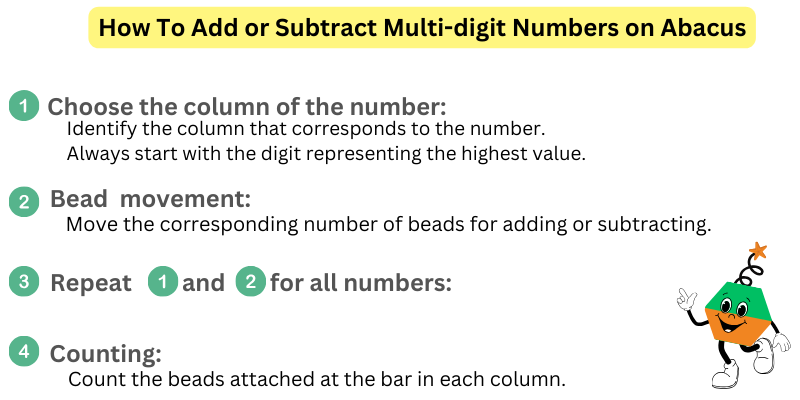

Let’s walk through a few examples using the table above.
This will give you a clear picture of how adding or subtracting multi-digit numbers works.
Simple multi-digit addition
Example 1: [12 + 26]
- Choose the colum of the first number: The first number is 12. It’s 2-digit number, and the higher digit is the tens place. Thus, we will add 10 in the tens column first.
- Bead Movement: Move 1 lower bead up toward the bar in the tens column. Then, go to the ones column to add 2 by moving 2 lower beads up toward the bar.
- Choose the column of the second number: The second number is 26. It’s also a 2-digit number, and the higher digit is the tens place. Thus, we will start adding 20 in the tens column first.
- Bead Movement: Move 2 lower beads toward the bar in the tens column. Then, go to the ones column to add 6 by moving the upper bead and 1 lower bead toward the bar.
- Count the number of beads attached at the bar in each column, tens and ones, to determine the sum. It’s 38. Therefore, 12+26=38.
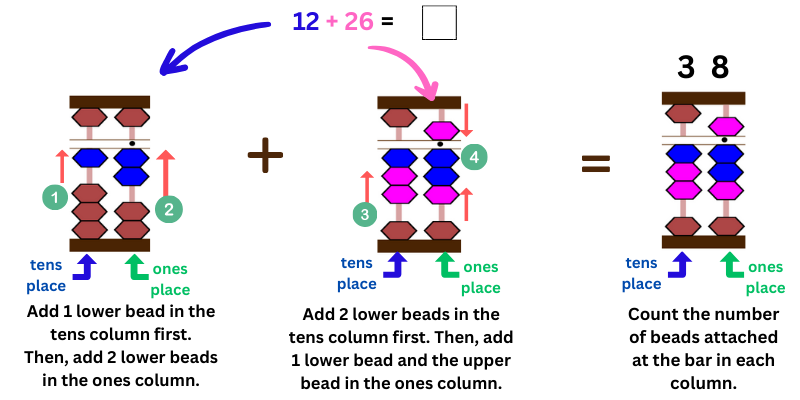

Example 2: [51 + 33]
- Choose the colum of the first number: The first number is 51. It’s 2-digit number, and the higher digit is the tens place. Thus, we will add 50 in the tens column first.
- Bead Movement: Move the upper bead down toward the bar in the tens column. Then, go to the ones column to add 1 by moving 1 lower bead up toward the bar.
- Choose the column of the second number: The second number is 33. It’s also a 2-digit number, and the higher digit is the tens place. Thus, we will start adding 30 in the tens column first.
- Bead Movement: Move 3 lower beads toward the bar in the tens column. Then, go to the ones column to add 3moving 3 lower beads toward the bar.
- Count the number of beads attached at the bar in each column, tens and ones, to determine the sum. It’s 84. Therefore, 51+33=84.
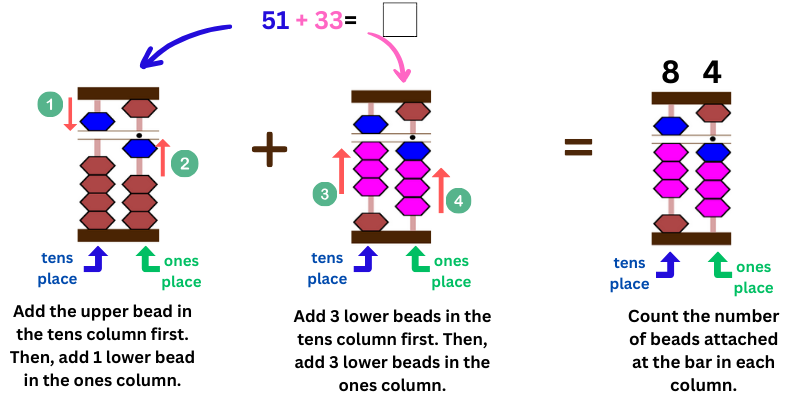

Example 3: [10 + 23 + 51]
- Choose the colum of the first number: The first number is 10. It’s 2-digit number, and the higher digit is the tens place. Thus, we will add 10 in the tens column first.
- Bead Movement: Move 1 lower bead up toward the bar in the tens column. No bead to add in the ones column.
- Choose the column of the second number: The second number is 23. It’s also a 2-digit number, and the higher digit is the tens place. Thus, we will start adding 20 in the tens column first.
- Bead Movement: Move 2 lower beads toward the bar in the tens column. Then, go to the ones column to add 3 by moving 3 lower beads up toward the bar.
- Choose the column of the third number: The third number is 51. It’s a 2-digit number, and the higher digit is the tens plae. Thus, we will add 50 in the tens column first.
- Bead Movement: Move the upper bead down toward the bar, the go to ones column to add 1 by moving 1 lower bead toward the bar.
- Count the number of beads attached at the bar in each column, tens and ones, to determine the sum. It’s 84. Therefore, 10+23+51=84.
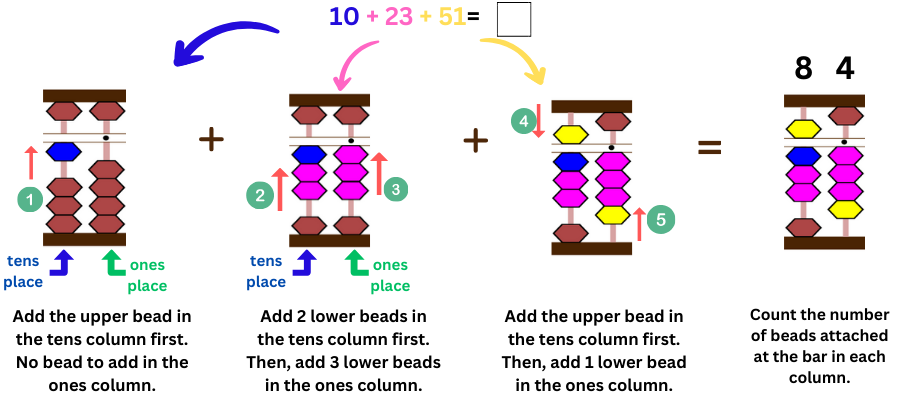

Simple Multi-digit Subtraction
Example 1: [94 - 73]
- Choose the colum of the first number: The first number is 94. It’s 2-digit number, and the higher digit is the tens place. Thus, we will add 90 in the tens column first.
- Bead Movement: Move the upper bead and 4 lower beads up toward the bar in the tens column. Then, go to the ones column to add 4 by moving 4 lower beads up toward the bar.
- Choose the column of the second number: The second number is 73. It’s also a 2-digit number, and the higher digit is the tens place. Thus, we will start subtracting 70 in the tens column first.
- Bead Movement: Move 2 lower beads and the upper bead away from the bar in the tens column. Then, go to the ones column to subtract 3 by moving 3 lower beads away from the bar.
- Count the number of beads attached at the bar in each column, tens and ones, to determine the sum. It’s 21. Thus, 94-73=21.

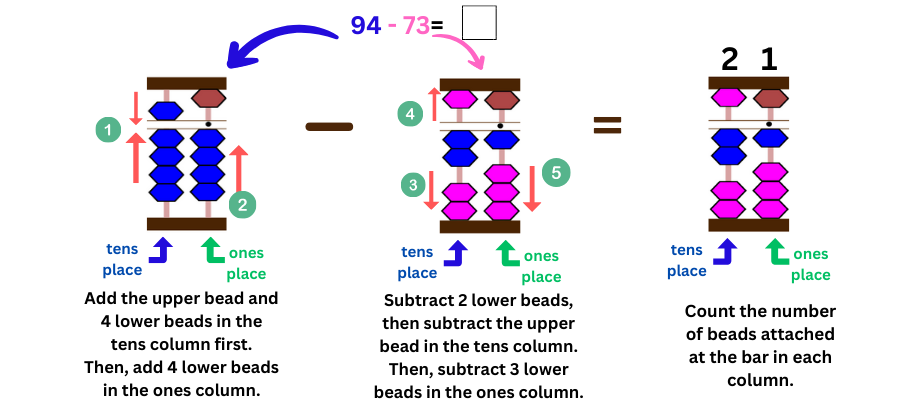

Example 2: [62 - 52]
- Choose the colum of the first number: The first number is 62. It’s 2-digit number, and the higher digit is the tens place. Thus, we will add 60 in the tens column first.
- Bead Movement: Move the upper bead and 1 lower bead up toward the bar in the tens column. Then, go to the ones column to add 2 by moving 2 lower beads up toward the bar.
- Choose the column of the second number: The second number is 52. It’s also a 2-digit number, and the higher digit is the tens place. Thus, we will start subtracting 50 in the tens column first.
- Bead Movement: Move the upper bead away from the bar in the tens column. Then, go to the ones column to subtract 2 by moving 2 lower beads away from the bar.
- Count the number of beads attached at the bar in each column, tens and ones, to determine the sum. It’s 10. Thus, 62-52=10.
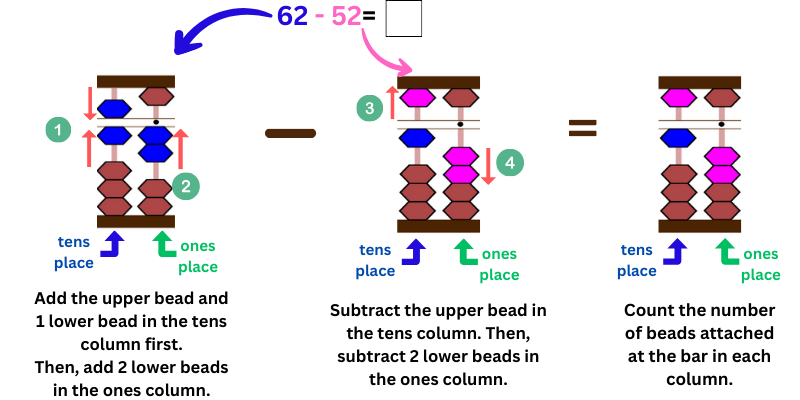

Example 3: [25 + 53 - 65]
- Choose the colum of the first number: The first number is 25. It’s 2-digit number, and the higher digit is the tens place. Thus, we will add 20 in the tens column first.
- Bead Movement: Move 2 lower beads up toward the bar in the tens column. Then, go to the ones column to add 5 by moving the upper bead toward the bar.
- Choose the column of the second number: The second number is 53. It’s also a 2-digit number, and the higher digit is the tens place. Thus, we will add 50 in the tens column first.
- Bead Movement: Move the upper bead toward the bar in the tens column. Then, go to the ones column to add 3 by moveing 3 lower beads toward the bar.
- Choose the column of the third number: The third number is 65. It’s also a 2-digit number, and the higher digit is the tens place. Thus, we will subtract 60 in the tens column first.
- Bead Movement: Move the 1 lower bead and the upper bead in the tens column away from the bar. Then, go to the ones column to subtract 5 by moving the upper bead away from the bar.
- Count the number of beads attached at the bar in each column, tens and ones, to determine the sum. It’s 13. Thus, 25+53-65=13.


Video Lesson for Simple Multi-digit Addition & Subtraction

Practice Questions
Work through all the worksheet or video problems multiple times until you feel confident with addition and subtraction with multi-digit numbers. Follow the steps and find the right column to add or subtract. Pay attention to using the right fingers for each operation. Consistent practice will enhance your skills.
Click the green button below to access the printable worksheets.
Access the video below to try the video practice questions below.


So far, we’ve covered basic addition and subtraction without any carrying over or borrowing. Now, we’re not just crunching single-digit numbers anymore—we’re diving into multi-digit territory. The key is to spot the digit with the highest place value and start from there when adding or subtracting.
While we’ve tackled multi-digit numbers, our operations have remained straightforward. But in our upcoming lessons, we’ll explore using the upper bead and higher place values. This comes into play when we run out of lower beads for adding or subtracting. We’ll introduce a handy technique called the “friend approach” to speed up our calculations. Mastering this technique is crucial in abacus learning, so make sure to get comfortable with it.
Ready to level up your skills? Let’s dive in and explore these new techniques together!

